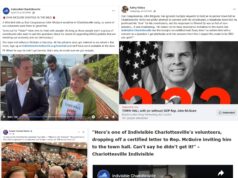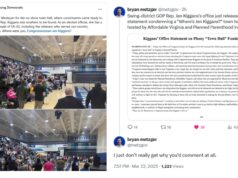 It’s a quiet weekend, so I decided to take a look at how Virginia candidates were doing on social media as we reach the traditional kickoff – Labor Day – of the fall campaign season. In the most competitive Virginia State Senate and House of Delegates races, a few things jumped out at me.
It’s a quiet weekend, so I decided to take a look at how Virginia candidates were doing on social media as we reach the traditional kickoff – Labor Day – of the fall campaign season. In the most competitive Virginia State Senate and House of Delegates races, a few things jumped out at me.
First, almost nobody is using YouTube or video content much at all. Two exceptions to this rule are Republicans Glen Sturtevant (in the 10th State Senate district) and Hal Parrish (in the 29th State Senate district), both of whom have active YouTube channels and significant number (e.g., over 10k) video views. Other than that, we might as well be in the pre-YouTube era back in 2005, because basically none of the other State Senate and House of Delegates campaigns I looked at are using that social media tool.
As for Twitter, which is a great way to reach the media and core supporters, Republican State Senator Dick Black really stands out, with 3,337 Twitter followers and 143 original tweets (not counting “retweets”) just since August 1. In that race, Black’s opponent, Democrat Jill McCabe, has about one-tenth of Black’s Twitter followers and has tweeted a bit over 20% as much as Black has since August 1.
Another key State Senate race is in the 10th district, where Glen Sturtevant (mentioned above) is facing Democratic nominee Dan Gecker. When it comes to Twitter, Sturtevant has a huge lead on Gecker, who inexplicably waited until August 27 to even open a Twitter account. The result: Sturtevant has 1,481 Twitter followers and has tweeted 19 times since August 1, while Gecker has just 57 Twitter followers (4% of Sturtevant’s) and has tweeted just 5 times since August 1.
A bit of better news for Democrats on the Twitter front: Sen. John Edwards has nearly three times the followers (601-238) of his Republican opponent, Nancy Dye (although Dye has tweeted 13 times since 8/1, while Edwards has not tweeted at all – hmmmm); Democratic nominee Jeremy McPike (29th district) has a 683-226 lead in Twitter followers over his Republican opponent, Hal Parrish, with McPike out-tweeting Parrish since 8/1 by a 9-6 margin; Democrat Gary McCollum leads State Sen. Frank Wagner (R-7th district) 212-71 in Twitter followers, and has out-tweeted Wagner 9-0 since 8/1; Sen. Lynwood Lewis (D-6th) leads his Republican challenger Richard Ottinger 490-98 in Twitter followers, and has out-tweeted Ottinger 3-0 since 8/1; Democrat Scott Surovell has an enormous Twitter followers lead (3,300-123) over his Republican opponent Jerry Foreman in the 36th district and is out-tweeting him as well.
The story is not necessarily the same on Facebook, as some candidates focus more on one social media outlet than another. For instance, while John Edwards leads Nancy Dye on Twitter, Dye leads Edwards (1,375-996 “likes”) on Facebook, and is also more active than Edwards (20-8 in terms of Facebook status updates since 8/1). Looking at the
29th State Senate district, while Democrat Jeremy McPike leads Republican Hal Parrish on Twitter, Parrish has approximately double McPike’s Facebook “likes” (2,204-1,110), although McPike is a bit more active in terms of posting on his Facebook page. Also, while Democrat Gary McCollum leads Sen. Frank Wagner on Twitter, Wagner has far more Facebook followers (3,334-716), although Wagner hasn’t updated a single time since 8/1, while McCollum has posted to his page 13 times.
Meanwhile, in the 13th State Senate district, the pattern is similar to Twitter, with Sen. Dick Black far ahead of Democrat Jill McCabe in terms of “likes” (8,849-964), although McCabe is a bit more active in terms of Facebook posting than Black (42-30 status updates since 8/1). Same thing in the 6th district (Lynwood Lewis leads Richard Ottinger by a 3:1 margin in Facebook “likes”); the 13th district (Sen. Dick Black leads Democrat Jill McCabe 8,849-965 in Facebook “likes”); and the 36th (Democrat Scott Surovell leads Republican Jerry Foreman 4:1 in Facebook “likes”).
Of course, “likes” aren’t everything, as Facebook’s funky algorithm – which decides what it “thinks” you want to see in your feed – means that posting more frequently might not lead to more followers actually seeing and/or engaging with your status updates. Thanks a lot, Mark Zuckerberg! LOL So take the numbers here with a grain of salt. Also keep in mind that one strong post that gets picked up by the corporate media, blogs, etc. (example: the recent dustup between Republican John Guevara and Democrat Kathy Smith, in which Smith’s campaign and others criticized Guevara for “sexist” comments, got picked up by the Washington Post and numerous Virginia political blogs, including this one) can outweigh a bunch of posts that get no traction.
Post continues on the “flip,” with some comments on House of Delegates and Fairfax County Board contests
House of Delegates
Again, I’m not seeing YouTube being used, other than by Del. Tag Greason (although he only has 910 total views on his channel). On Facebook and Twitter, Republicans have the edge in key races in terms of “likes” and “followers,” respectively, although that mostly appears to be related to the fact that they also hold an incumbent advantage as well. Three Democrats – Josh King, Laurie Buchwald and Willie Randall – don’t have Twitter accounts at all, although in the cases of King and Randall, their Republican opponents (Mark Dudenhefer and Rob Bloxom) aren’t really active on Twitter either. One candidate who really likes to Tweet is Republican Sang Yi in the 37th House of Delegates district, with 57 tweets to his 521 followers just since 8/1. In contrast, Yi’s opponent, Democratic Del. David Bulova, has twice as many Twitter followers but isn’t really using this tool, having only tweeted three times since 8/1. Which of course raises an important point: amassing “followers” or “likes” or whatever on social media is fine and dandy, but it doesn’t do you much good if you don’t use the tools to communicate with your followers…
A few others that jumped out at me in the most competitive House of Delegates races: Republican Del. Ron Villanueva has a huge edge on Twitter (1,610-148 followers; 25-0 in terms of tweets since 8/1) over his Democratic challenger, Susan Hippen; Republican Del. Scott Lingamfelter has many more Twitter followers than his Democratic opponent, Sara Townsend, but she’s using that social media tool more, with a 12-2 edge in the # of tweets since 8/1; Del. Kathleen Murphy (D) maintains an edge over her Republican challenger Craig Parisot in Twitter followers (859-549), but Parisot has more “likes” on Facebook (1,786-1,591) and is more active on both social media outlets than Murphy (24-16 in # of tweets since 8/1; 26-12 in # of FB posts since 8/1); Del. Monty Mason (D) has a 10:1 edge on his Republican challenger, Lara Overy, in terms of Twitter followers, and also is tweeting more frequently (11-5 since 8/1); Del. David Yancey (R) has a big edge in Twitter followers (833-191) over his Democratic challenger, Shelly Simonds, but Simonds has out-tweeted him 22-5 since 8/1; Democrat Jennifer Boysko has an edge over her Republican challenger Danny Vargas in both Twitter followers and Facebook likes, but Vargas is using the tools about as much, or slightly more (20-15 since 8/1 in terms of FB status updates) than Boysko.
Fairfax County Board of Supervisors
Democrat John Foust has a huge edge (4,593-266) in terms of Twitter followers over his Republican challenger, Jennifer Chronis (note: this is almost certainly the result, at least in part, of Foust’s run for Congress last year), and is tweeting more frequently (22-11 since 8/1) as well. It’s closer in terms of Facebook followers (Foust 1,585-Chronis 541), while Chronis is actually more active on Facebook (20-10 in terms of updates since 8/1) than Foust.
In Sully district, Democrat Kathy Smith doesn’t have a Twitter account at all (why not?), while Republican John Guevara has a small number (155) of Twitter followers. What’s interesting is that Guevara has tweeted a whopping 88 times to those 155 followers since 8/1. On Facebook, Guevara has a slight edge over Smith (276-252) in terms of “likes,” and has also updated his page very frequently (50 times since 8/1), while Smith has updated just four times since 8/1.
In the Mt. Vernon district, neither candidate – Democrat Dan Storck or Republian Jane Gandee – seems to be a big fan of social media, with just 21 Twitter followers and 10 tweets combined between the two of them, with Storck maintaining a 261-213 edge in terms of Facebook “likes” (although Gandee has updated her page 24 times vs. 14 for Storck since 8/1).
Finally, in the Braddock district, incumbent Supervisor John Cook (R) has been active on Twitter, with 36 tweets to his 908 followers since 8/1. For her part, Democrat Janet Oleszek has tweeted just 5 times to her 256 Twitter followers since 8/1. On Facebook, Cook holds a 548-196 edge over Oleszek in terms of “likes,” while neither has posted much since 8/1 (4 times for Cook, 3 for Oleszek).
***************************
P.S. One last thing: I haven’t seen Democratic candidates (with a couple exceptions, particularly April Moore, who’s an excellent progressive candidate running against Mark Obenshain in a heavily “red” district) using Blue Virginia (or other Democratic blogs) much this cycle, either in absolute terms or relative to previous cycles. It’s not much different on the Republican side. For instance, I checked The Bull Elephant for the past few weeks, and there hasn’t been much coverage of House of Delegates or State Senate races, with most coverage focused on presidential politics, redistricting, statewide Virginia stuff, etc. I DID see coverage of the Smith-Guevara matchup in Fairfax County’s Sully district, but other than that…not much. Same thing, pretty much, on the other large Virginia conservative blog, Bearing Drift. In general, there just doesn’t seem to be a great deal of interest or “buzz” on races for School Board, County Board, Virginia House of Delegates or Virginia State Senate at this point in the cycle – Labor Day weekend – even among the hardest core of the political junkies in the state. It seems very weird to me, especially given that partisan control of the State Senate is at stake in just 59 days or so. It’s also very different than I remember from past off/odd-year election cycles in Virginia…



 Sign up for the Blue Virginia weekly newsletter
Sign up for the Blue Virginia weekly newsletter

![“Skilled” at Breaking the Law: “This latest attempt to sidestep any regulations or oversight shows [that ‘skill’ game developers] have no interest in acting responsibly or in good faith.”](https://bluevirginia.us/wp-content/uploads/2024/10/krizekskilled-238x178.jpg)





